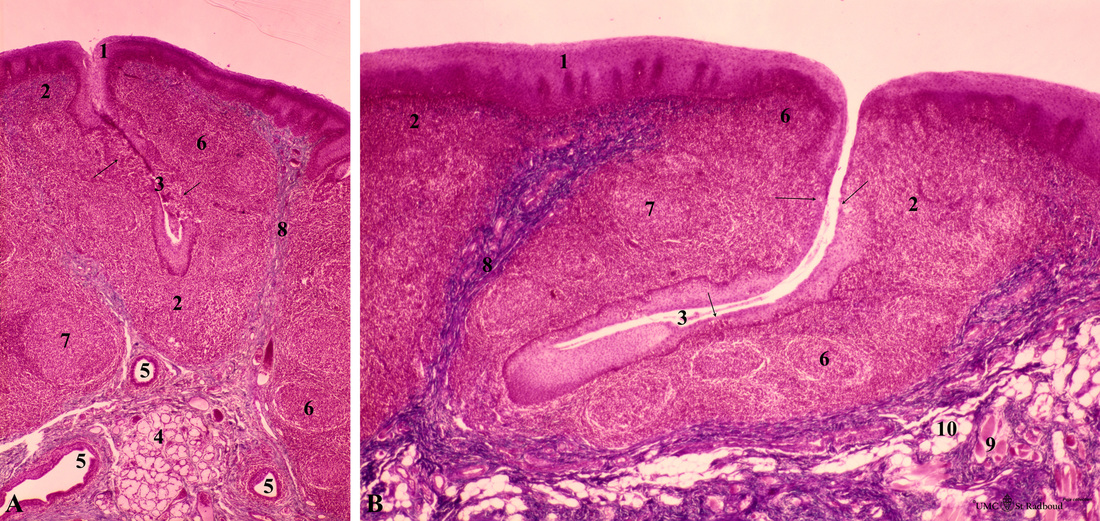2.4 POJA-L1060+1061
Title: Lingual tonsil (‘lymphoepithelial tissue’ gut-associated lymphatic tissue or GALT) (human)
Description: Stain: Azan. A: Survey; B: detail of the crypt.
The lingual tonsil consists of accumulations of bulging lingual lymphatic follicles in the dorsal part of the tongue behind the terminal sulcus, and belongs to the so-called Waldeyer’s ring of pharyngeal lymphatic tissue.
The left (A) and right (B) pictures show two different areas of the bulging diffuse lymphatic tissue on the tongue. Non-keratinized stratified squamous epithelium (1) covers the accumulations of lymphatic tissue (2); deep invaginations (crypts) (3) are present where mucous glands (posterior lingual gland) (4) drain via excretory duct (A, 5) into the lumen. Primary nodules (6) as well as few secondary ones with germinal centres (7) are found within the diffuse lymphatic tissue.
Blue-stained fibrous tissues are connective tissue septa derived from the fascia (8) of the muscle tissue (palatoglossal muscle) (9).
(A): (→) indicate desquamated and detached epithelium due to heavy infiltration and diapedesis of lymphocytes, in this area the epithelial-connective tissue boundary (basement membrane) disappears.
(B): (→) onset of the process of desquamation. (10) Fat cells within the underlying fascia of the palatoglossal muscle.
Keywords/Mesh: lymphatic tissue, lingual tonsil, GALT, lymphoepithelial tissue, stratified squamous epithelium, reticular tissue, histology, POJA collection
Title: Lingual tonsil (‘lymphoepithelial tissue’ gut-associated lymphatic tissue or GALT) (human)
Description: Stain: Azan. A: Survey; B: detail of the crypt.
The lingual tonsil consists of accumulations of bulging lingual lymphatic follicles in the dorsal part of the tongue behind the terminal sulcus, and belongs to the so-called Waldeyer’s ring of pharyngeal lymphatic tissue.
The left (A) and right (B) pictures show two different areas of the bulging diffuse lymphatic tissue on the tongue. Non-keratinized stratified squamous epithelium (1) covers the accumulations of lymphatic tissue (2); deep invaginations (crypts) (3) are present where mucous glands (posterior lingual gland) (4) drain via excretory duct (A, 5) into the lumen. Primary nodules (6) as well as few secondary ones with germinal centres (7) are found within the diffuse lymphatic tissue.
Blue-stained fibrous tissues are connective tissue septa derived from the fascia (8) of the muscle tissue (palatoglossal muscle) (9).
(A): (→) indicate desquamated and detached epithelium due to heavy infiltration and diapedesis of lymphocytes, in this area the epithelial-connective tissue boundary (basement membrane) disappears.
(B): (→) onset of the process of desquamation. (10) Fat cells within the underlying fascia of the palatoglossal muscle.
Keywords/Mesh: lymphatic tissue, lingual tonsil, GALT, lymphoepithelial tissue, stratified squamous epithelium, reticular tissue, histology, POJA collection

